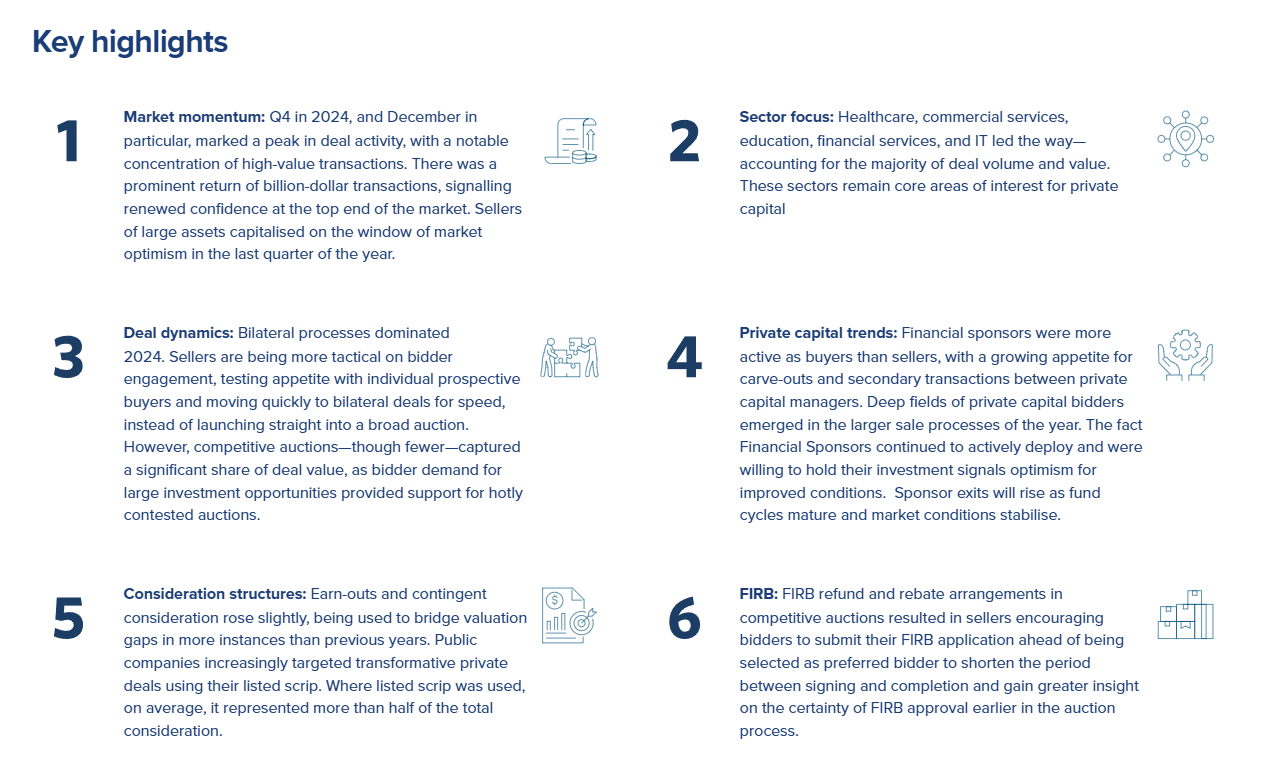This exclusive report unpacks a sample of over 60 private M&A transactions led by our Dealmakers—offering data-driven insights into a dynamic year of strategic execution, sector shifts, and evolving deal structures
Our 2025 Private M&A Report offers a data-driven view of the Australian private M&A market, drawing on a sample of over 60 transactions signed in 2024.
As market conditions improved—buoyed by stabilising interest rate expectations and renewed global confidence—deal activity surged, particularly in the final quarter of the year.
The Report covers the private M&A landscape and market practice on:
- Deal conditions and termination rights.
- Purchase price structures and mechanism.
- Claim arrangements – including limitation on liability regimes.
- Warranty & indemnity insurance – including recourse to sellers.
Herbert Smith Freehills Kramer played a leading role in this dynamic environment, advising across a broad spectrum of sectors and deal types. Our insights are grounded in real-world experience, enabling us to identify the trends shaping the market and the strategies that will define success in 2025 and beyond.

Looking ahead: Predictions for 2025 and beyond
 |
Tailwinds for sellers: Improved interest rate outlooks, a relatively low Australian dollar, and strong buyer appetite—particularly from private equity—are expected to drive a new wave of activity. Momentum will build and give confidence to sellers through 2025. The pipeline of assets is exceptionally strong, boding well for near-to-medium term activity. |
 |
 |
Carve-Outs on the rise: Corporate portfolio reviews and greater scrutiny on optimising the business mix are likely to fuel divestments. We saw this theme in 2024 and continues to build 2025. This will see opportunities for Strategic and Financial Sponsor buyers alike, but particularly private equity. |
 |
 |
Listed scrip deals: With IPO markets subdued, listed companies are increasingly using scrip to pursue transformative acquisitions—an emerging trend we expect to continue. Listed acquirers have been emboldened by the success of the Chemist Warehouse-Sigma transaction. For sellers, a new and attractive channel has been opened up to access public market valuations and synergy value creation. |
 |
 |
Regulatory shifts: Upcoming changes to ACCC notification requirements and FIRB incentives will reshape deal timelines and approval strategies, especially in competitive processes. Careful planning by bidders and sellers will be needed where signing is targeted in the next 6 months as to how to position for the merger reforms coming into effect from 1 Jan 2026. Tax will remain a key regulatory issue for foreign sellers and bidders with significant changes on the horizon to Australia’s foreign resident capital gains tax regime – which will include a new ATO notification process – and the ushering in of a new tax framework for FIRB approvals. |
 |
 |
Deal certainty in focus: In a climate of policy uncertainty, we expect buyers to place greater emphasis on material adverse change (MAC) clauses and conditionality. Buyers will be cautious of their acquisition assumptions will be undermined, while Sellers will prize deal certainty and use competitive tension to maximise this. We have already seen a few instances in large deals where MACs have been alleged by a buyer. Whether a MAC is adopted, how it is formulated and what is excluded will receive more scrutiny than ever. Now more than ever, the MAC debate will be hotly contested. |
 |
[View source.]